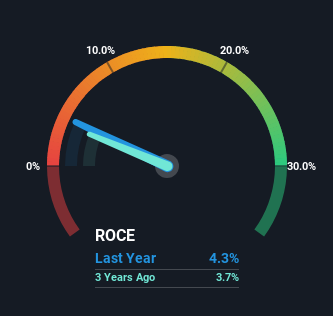Some Investors May Be Worried About Sarla Performance Fibers' (NSE:SARLAPOLY) Returns On Capital
What financial metrics can indicate to us that a company is maturing or even in decline? Typically, we'll see the trend of both return on capital employed (ROCE) declining and this usually coincides with a decreasing amount of capital employed. Ultimately this means that the company is earning less per dollar invested and on top of that, it's shrinking its base of capital employed. And from a first read, things don't look too good at Sarla Performance Fibers (NSE:SARLAPOLY), so let's see why.
Return On Capital Employed (ROCE): What Is It?
Just to clarify if you're unsure, ROCE is a metric for evaluating how much pre-tax income (in percentage terms) a company earns on the capital invested in its business. To calculate this metric for Sarla Performance Fibers, this is the formula:
Return on Capital Employed = Earnings Before Interest and Tax (EBIT) ÷ (Total Assets - Current Liabilities)
0.043 = ₹180m ÷ (₹5.8b - ₹1.6b) (Based on the trailing twelve months to June 2023).
Thus, Sarla Performance Fibers has an ROCE of 4.3%. In absolute terms, that's a low return and it also under-performs the Luxury industry average of 10%.
View our latest analysis for Sarla Performance Fibers

Historical performance is a great place to start when researching a stock so above you can see the gauge for Sarla Performance Fibers' ROCE against it's prior returns. If you'd like to look at how Sarla Performance Fibers has performed in the past in other metrics, you can view this free graph of past earnings, revenue and cash flow.
What Can We Tell From Sarla Performance Fibers' ROCE Trend?
We are a bit worried about the trend of returns on capital at Sarla Performance Fibers. About five years ago, returns on capital were 6.8%, however they're now substantially lower than that as we saw above. On top of that, it's worth noting that the amount of capital employed within the business has remained relatively steady. Since returns are falling and the business has the same amount of assets employed, this can suggest it's a mature business that hasn't had much growth in the last five years. If these trends continue, we wouldn't expect Sarla Performance Fibers to turn into a multi-bagger.
In Conclusion...
All in all, the lower returns from the same amount of capital employed aren't exactly signs of a compounding machine. However the stock has delivered a 69% return to shareholders over the last five years, so investors might be expecting the trends to turn around. In any case, the current underlying trends don't bode well for long term performance so unless they reverse, we'd start looking elsewhere.
On a final note, we've found 3 warning signs for Sarla Performance Fibers that we think you should be aware of.
While Sarla Performance Fibers isn't earning the highest return, check out this free list of companies that are earning high returns on equity with solid balance sheets.
New: Manage All Your Stock Portfolios in One Place
We've created the ultimate portfolio companion for stock investors, and it's free.
• Connect an unlimited number of Portfolios and see your total in one currency
• Be alerted to new Warning Signs or Risks via email or mobile
• Track the Fair Value of your stocks
Have feedback on this article? Concerned about the content? Get in touch with us directly. Alternatively, email editorial-team (at) simplywallst.com.
This article by Simply Wall St is general in nature. We provide commentary based on historical data and analyst forecasts only using an unbiased methodology and our articles are not intended to be financial advice. It does not constitute a recommendation to buy or sell any stock, and does not take account of your objectives, or your financial situation. We aim to bring you long-term focused analysis driven by fundamental data. Note that our analysis may not factor in the latest price-sensitive company announcements or qualitative material. Simply Wall St has no position in any stocks mentioned.
About NSEI:SARLAPOLY
Sarla Performance Fibers
Manufactures and sells yarns in India and internationally.
Flawless balance sheet with solid track record and pays a dividend.
Market Insights
Community Narratives



